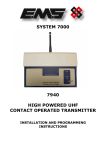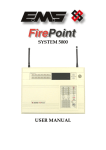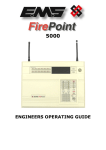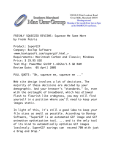Download EMS 7703 Technical information
Transcript
7703 INSTALLATION INSTRUCTIONS EMS SYSTEM 7000 Table of Contents Section Page No 1. INTRODUCTION ............................................................................................................ 3 2. INSTALLATION INSTRUCTIONS....................................................................................... 5 3. INSTALLATION NOTES................................................................................................... 8 3.1 RADIO INTERFERENCE. .................................................................................................. 8 3.2 RADIO RANGE. ........................................................................................................... 8 4. FUNCTIONS AND FEATURES .......................................................................................... 9 4.1 CLEAR MEMORY ........................................................................................................... 9 4.2 LOAD TRANSMITTER SERIAL IDENTITIES ............................................................................. 9 4.3 DELETE TRANSMITTER IDENTITY ......................................................................................10 5. USER INSTRUCTIONS ..................................................................................................10 5.1 INSTRUCTIONS ...........................................................................................................10 5.2 AUDIBLE WARNING .....................................................................................................10 5.3 KEYSWITCH ..............................................................................................................11 5.4 VISUAL INSTRUCTIONS .................................................................................................11 5.5 TAMPER AERIAL..........................................................................................................12 5.6 RADIO INTERFERENCE LED.............................................................................................12 5.7 ANTI-FALSE ALARM ......................................................................................................12 6. TRANSMITTER OPERATION............................................................................................13 7. TECHNICAL INFORMATION FOR THE 7703 RECEIVER .......................................................14 2 7703 INSTALLATION, ISSUE V2.2 – 13/04/10 EMS SYSTEM 7000 1. Introduction 1.1 The UHF singleway radio is ideal for use in all types of financial, or commercial premises where staff need the security of a personal attack system and also the freedom of mobility. The 7703 is a versatile compact UHF receiver for use with a selection of transmitters. These receivers can store up to 48 transmitter identification numbers. 1.2 There are 3 types of transmitter which are compatible with the 7703 these are, the portable, the money clip and a contact operated model, each have a typical range of 250 metres. The alkaline battery fitted will offer approximately one year’s battery life, dependent on frequency of use. A brief list of the features offered by the 7703 receiver is as follows: (a) LED display of Alarm, local and transmitter battery low. (b) Radio blocking interference detection. (c) Aerial tamper detection. (d) Anti false alarm. (e) Power supply failure warning. (f) Key switch for clear, reset and test. (g) Outputs from programmable Alarm and Local relays. (h) Low power operation. (i) Programmable audio warning. 1.3 The internal view of the 7703 receiver is shown below in Figures 1, 2 and 3. 3 7703 INSTALLATION, ISSUE V2.2 – 13/04/10 EMS SYSTEM 7000 Figure 1 Figure 2 Figure 3 4 7703 INSTALLATION, ISSUE V2.2 – 13/04/10 EMS SYSTEM 7000 2. Installation Instructions Before installing the 7703 receiver read these instructions with care. 2.1 When choosing a suitable site for the 7703 consider the following:(a) (b) The minimum recommended distance of metal objects or equipment from the aerial is 400mm. The minimum recommended distance to photocopiers, computers and fax machines is 2 metres. 2m FIXING SURFACE / WALL 2m 2m 2m DO NOT RUN CABLE DIRECTLY BEHIND AERIALS 400mm 2m 2m 2m 2m 7703 RECEIVER TO BE MOUNTED AT LEAST 2m AWAY FROM OTHER ELECTRICAL DEVICES 2.2 Having chosen a suitable site, place the receiver in or near its final position. Fit the special aerial provided and connect power to the receiver as per the provided connection drawing. On power-up the 7703 will self test. The self test will cause the internal sounder to sound for approximately 1 second. In addition the front panel LED's will light momentarily in the following order: Clear LED, Test LED, Power LED, Radio Interference LED, Low Battery LED, Local LED and Alarm LED. This cycle will be repeated a number of times. The number of repetitions determines the state of the receiver as shown in Table 1. Cycles 3 3 1 Radio Status EEPROM OK. Clear LED steady means transmitters in memory EEPROM OK. Clear LED flashing means no transmitter's in memory EEPROM failure Table 1 The above sequence of events will also occur if the reset button on the receiver board is pressed. 2.3 To check for radio interference using the integral carrier detector, turn the keyswitch to the TEST position. The red RADIO INTERFERENCE LED will light if spurious radio signals are present. Re-site the 7703 if necessary. 2.4 Load the serial identities of the transmitters to be used with the system, see section 4.2. 2.5 Check the signal from each transmitter can reach the receiver from their intended locations. 5 7703 INSTALLATION, ISSUE V2.2 – 13/04/10 EMS SYSTEM 7000 2.6 If the front panel has not already been unscrewed, undo and remove the 4 screws holding the front panel to the main body of the receiver. Disconnect power and remove the battery if fitted. The front panel will now be suspended from the black retaining strap. 2.7 Hold the receiver body in its final position and mark the 4 fixing holes. Knock out the appropriate cable entry point to allow connections to be made to the receiver. Ensure that the cable entry point selected affords the shortest possible cable run inside the receiver. 2.8 Reconnect the power cable and battery connections removed in 2.6 above. Before replacing the front panel select the appropriate Receiver and Buzzer options using the switches as shown below in accordance with Tables 2, 3 and 4 which outline the available options. Switch 1 Function Local Relay Switch On Latched Switch Off On for period of transmission + 2 seconds N/O going closed 2 3 Contact type Buzzer Alarm Buzzer permitted Alarm Buzzer Inhibited 4 Alarm Relay Latched 5 Buzzer 6 Contact transmitters On for period of transmission + 2 seconds No buzzer for valid transmissions Alarm transmitter N/C going open Buzzer for period transmission + 1 second Local of Table 2 Switches 7 and 8 are used to select the type of transmitter being used SW 7 Off Off ON SW8 Off ON OFF Transmitter Type Opposed Buttons for Full Alarm Three Buttons for Full Alarm Non Opposed Buttons for Full Alarm Table 3 6 7703 INSTALLATION, ISSUE V2.2 – 13/04/10 EMS SYSTEM 7000 Switch 1 Buzzer follows Alarm LED Switch On 2 Buzzer Follows Local LED 3 Buzzer sounds for 4 seconds in Clear and Test 4 Buzzer Follows Low Battery LED 5 6 Buzzer sounds when receiving any valid transmission with key in TEST Buzzer follows RI LED (not with Key in TEST) 7 Buzzer sounds on mains fail 8 Buzzer follows Local LED but with 5 second delay Table 4 2.9 Check all options, functions and relays operate correctly. shown in Table 5. Transmitter Operation Green button pressed Both side buttons pressed The relays should operate as Relay Operation Local relay operates. Alarm, relay operates. Table 5 2.10 Re-check 2.5. 2.11 Holding the front panel to the main body of the receiver add the 4 screws previously removed. 7 7703 INSTALLATION, ISSUE V2.2 – 13/04/10 EMS SYSTEM 7000 3. Installation Notes 3.1 Radio Interference. 3.1.1 Door access systems, photocopiers, fax machines, modems, processor controlled security controllers and digital telephone exchanges are a few of the items that on occasion may emit spurious signals. If the spurious emissions correspond to the co-channel or adjacent channel frequencies, they may interfere with the performance despite the careful 7703 receiver design. 3.1.2 Two meters distance from the aerial is usually sufficient to eliminate their effects but door access systems have been known to require a greater distance. Do not over look the possibility of there being apparatus on the opposite side of the wall to which the receiver is to be installed, which is not the property of the installation site. 3.1.3 With TEST mode selected the RADIO INTERFERENCE LED is connected to an integral carrier detector. This detector will turn ON if any radio signal exceeding -110 DBM is found within the channel used by the 7703. 3.2 Radio Range. 3.2.1 The expected range of a transmitter may not be achieved for a variety of reasons. The local environment is normally responsible and a few of these reasons are as follows:(a) (b) (c) (d) (e) Radio interference. Metal tiled floors, walls or ceilings. Metal framed suspended ceilings. Metal foil wall covering under the decorations used for thermal insulation Metal objects or equipment on the opposite side of the wall to which the receiver is installed. Problems caused by the above may be reduced by:(1) (2) Re-siting the receiver. Fitting a remote aerial. 8 7703 INSTALLATION, ISSUE V2.2 – 13/04/10 EMS SYSTEM 7000 4. Functions and Features 4.1 Clear Memory To clear the transmitter serial ident Memory as follows: (a) (b) (c) (d) (e) (f) (g) Detach the front panel from the case leaving all the connecting cables intact. Select RESET mode with the key switch. Depress and hold both the transmitter ADD and DELETE switches adjacent to the processor. Momentarily depresses the MASTER RESET switch adjacent to the transmitter DELETE switch. When the buzzer has bleeped 3 times release the switches. Select CLEAR mode using the keyswitch. The green CLEAR LED will flash if the routine was completed correctly, otherwise repeat from (b). Refit the front panel. 4.2 Load Transmitter Serial Identities 4.2.1 For the 7703 to recognise the transmitters assigned to it the identity of each transmitter must be stored in its memory. The memory can store up to 48 different numbers. Each transmitter has a unique number and there are 2 methods for loading the receiver's nonvolatile memory with these numbers. There is a time limit of 5 seconds each for loading and confirming a transmitter's indent number, five flashes of the Red Alarm (load) or green local (confirm) LED’s respectively. When the Red Alarm LED flashes for loading, transmit using a Local signal (see Table 5). (The same signal must be used for confirmation as was used for loading). 4.2.2 Method (a) (b) (c) (d) (e) Select RESET mode using the key switch: Turn the key to TEST and back to RESET position 3 times. Allow not more than 1 second between switching actions. The Red Alarm LED will flash showing the MEMORY is now open for loading the transmitter ident number. Activate a transmitter, using a Local activation. If the ident is accepted the green Local LED will flash asking for confirmation and a long bleep will be heard. Activate a transmitter again, using a Local activation. If the confirmation is accepted 3 short bleeps will be heard and the Yellow Low Battery LED will flash to acknowledge storage. Repeat from (a) for each transmitter ident to be loaded. 9 7703 INSTALLATION, ISSUE V2.2 – 13/04/10 EMS SYSTEM 7000 Notes: If the Green LED flashes only once, the confirmation signal did not match the Load signal. Repeat from (a). If the Yellow LED does not flash to acknowledge storage, the identity number is already stored in the memory. The POWER LED will turn off during the loading routine. 4.3 Delete Transmitter Identity (a) (b) (c) (d) (e) (f) (g) With either CLEAR or TEST mode selected: Depress and hold the internal transmitter DELETE switch. Select RESET mode using the key switch. The Green Local LED will flash. Release the DELETE switch. The MEMORY is now open for deleting the ident number. Activate a transmitter, using a Local activation. If the ident is accepted the Red Alarm LED will flash asking for confirmation and a long bleep will be heard. Activate a transmitter again, using a Local activation. If the confirmation is accepted 3 short bleeps will be heard and the Yellow Low Battery LED will flash to acknowledge deletion. Repeat from (a) for each transmitter ident to be deleted. Notes: To delete a specific transmitter number the transmitter must be available and routine 4.3 used. When a transmitter is lost, the 7703's Memory must be cleared using routine 4.1 and the transmitter serial ident number re-loaded using routine 4.2. 5. User Instructions 5.1 Instructions Though the 7703 has many features it is very easy to use. Any of the visual indicators can be accompanies with an audible warning but these would normally be selected at the time of installation. The only user control is the key switch. The 7703 will only recognise the transmitters whose identity numbers have been stored in it's memory. The identity numbers will remain safely stored in the memory, even in the event of total power failure. 5.2 Audible Warning 5.2.1 Audible warning can be selected to accompany any of the visual indicators in addition, special selections can be made as follows : 5.2.2 Five second delay of warning. 5.2.3 Clear mode not set, bleeps 3 times every 2 minutes. Any of the above selections are best made and initialised at the time of commissioning. These are made using the internal switches. 10 7703 INSTALLATION, ISSUE V2.2 – 13/04/10 EMS SYSTEM 7000 5.3 Keyswitch 5.3.1 With the keyswitch in the CLEAR position, the green CLEAR and Amber POWER LED's are ON. This signifies the 7703 is active and waiting for signals from the assigned transmitters. If a signal is received at the same time of switching from reset to clear the anti-false alarm function will hold the 7703 in test (with the alarm relay locked) until the signal ceases, when clear mode will automatically be activated. 5.3.2 Turning the keyswitch to RESET will cancel all functions activated. The display will be cleared and all LED's will return to their normal status: i.e., (a) (b) (c) (d) The CLEAR LED will be of OFF. The relays will be held inactive, no alarm can be caused. An active audible warning will be turned OFF. An audible warning will bleep 3 times every 2 minutes to indicate CLEAR mode is NOT selected. 5.3.3 With the keyswitch turned to the TEST position this allows the 7703 and its assigned transmitters to be tested. The relays will be held inactive, no alarm can be caused, although "Full" alarm, "Local" alarm and "Low Battery" LED’s will respond to signals from the transmitters. The display LED’s will momentarily operate and the audible warning will operate if the options were previously selected. 5.4 Visual Instructions (a) CLEAR: Green "clear" LED on and steady signifies the system is active, waiting for an Alarm signal. This LED will turn off if a "Full" or "Local" alarm is received. The "Clear" LED will flash if the memory block for recording the identity of the system transmitter identities is empty. (b) TEST : Red "test" LED on signifies the system is ready for testing. The relays are locked and cannot cause an alarm. The radio interference LED will light if a system transmitter in range is operated or, for any radio interfering signal tuned to the same channel as the receiver. (c) ALARM: When an alarm signal is received the RED alarm LED will light and alarm relay deenergise. The LED will remain on until system is reset. The user can select for latching or momentary operation of the alarm relay at the time of commissioning. (d) LOCAL: When a "Local" signal is received the GREEN local LED will light and local relay energise. The LED will remain on until the system is reset. The user can select for latching or momentary operation of the local relay at the time of commissioning. (e) LOW BATTERY: The amber LED will flash to indicate when the receiver battery or the DC supply is low. The LED will continuously light if a low battery signal is received from a transmitter. (f) POWER: The power LED is ON when the unit is powered from the mains and FLASHES if the mains is interrupted. This is latched, if the interruption is for more than 4 minutes. It will remain latched until the key is turned to the RESET position. 11 7703 INSTALLATION, ISSUE V2.2 – 13/04/10 EMS SYSTEM 7000 (g) RADIO INTERFERENCE: KEY IN CLEAR. 30 seconds of an unrecognisable signal will cause the RED RFI LED to turn on. The LED will flash if the signal ceases. Thereafter, the LED will light steadily for any RF interference signal which exceeds one second. Turn the key to reset to clear the display. With the KEY IN TEST, the RFI LED will follow any RF signal. It is possible to receive a valid alarm with no Carrier Detect occurring, as the receiver can decode valid data where the carrier is 10DB below the Carrier Detect level. 5.5 Tamper Aerial 5.5.1 The aerial supplied with the 7703 is special and should not be substituted for any other aerial, unless it has been recommended by E.M.S Limited. Should the aerial be cut or removed from its BNC connector a LOCAL ALARM will be signalled. If the buzzer option is selected the audible warning will operate continuously, see Buzzer Option table 4. The LOCAL ALARM can only be cleared by installing a serviceable aerial of the same type. 5.6 Radio Interference LED 5.6.1 With TEST mode selected the Red RADIO INTERFERENCE LED will light if any radio signal tuned to the channel used by the 7703 is received. This includes the transmitters assigned to the 7703. With CLEAR mode selected the RADIO INTERFERENCE LED will light if an interfering radio signal is received for a period exceeding 30 seconds. This only applies to signals not recognised by the 7703. 5.7 Anti-false Alarm 5.7.1 Should an ALARM or LOCAL signal be received at the same time as CLEAR mode is selected, the Anti-false alarm routine will take control and hold the 7703 in the TEST routine until the signal terminates. During the waiting period the Green CLEAR LED will remain OFF, the Red TEST LED will be ON and the Red RADIO INTERFERENCE will be ON announcing the presence of an unwanted signal. Providing the CLEAR mode remains selected, when the signal terminates the 7703 will then automatically release the TEST routine and change to CLEAR mode. Only the green CLEAR LED and Amber POWER LED will remain ON. 12 7703 INSTALLATION, ISSUE V2.2 – 13/04/10 EMS SYSTEM 7000 6. Transmitter Operation 6.1 The following instructions show the operation of the 7900 hand held transmitters. 6.2 The portable transmitter shown below operates in the following manner when configured to work as opposed action: Green pushbutton pressed Red pushbutton pressed Both red buttons pressed together 6.3 Local alarm Initiated No effect Full alarm Initiated If the transmitter is configured to work as non-opposed action, the operation is; Green pushbutton pressed Red pushbutton pressed Both red buttons pressed together Green and either red button pressed 6.4 Local alarm Initiated No effect No effect Full alarm Initiated If the transmitter is configured to work as triple action, the operation is; Green pushbutton pressed Red pushbutton pressed Both red buttons pressed together Green and either red button pressed All three buttons pressed Local alarm Initiated No effect No effect No effect Full alarm initiated 6.5 Alarm Latch memory, if on pressing a single red button the Red Light indicates on the handset, a full alarm has been initiated from the hand push within the last 12 hours. 6.6 Battery low is indicated by the yellow light coming on when a local or alarm activation is sent. GREEN BUTTON RED BUTTON RED BUTTON 13 7703 INSTALLATION, ISSUE V2.2 – 13/04/10 EMS SYSTEM 7000 7. Technical Information For The 7703 Receiver Dimensions: Weight of 7703 (DC version) Operating Frequency: Channel Spacing: Modulation: Deviation: Sensitivity: R.S.S.I: A.F.C: Antenna Input: Radio Blocking Detection: Power of 7703: Low supply flag at: Relay contact rating: Operation Temperature: Humidity: 230mm x 150mm x 68mm 1.4 G (Without Battery) 458.50 to 458.80 MHZ (MPT 1329) 25 KHZ FSK NBFM +/- 2.4 KHZ -120 DBM for 12 DB SINAD Analogue, Dynamic range 80 DBM +/- 3 KHZ 50R Signals exceeding -110 DBM 240 VAC 50 HZ at 7.5 VA 10.5 or 21 VDC selectable 24 VDC at 1 AMP MAX, 28VA -10 to 55 degrees centigrade Up to 75% non Condensing. 14 7703 INSTALLATION, ISSUE V2.2 – 13/04/10 EMS SYSTEM 7000 15 7703 INSTALLATION, ISSUE V2.2 – 13/04/10 EMS SYSTEM 7000 Dealer Information: EMS Group Head Office Technology House, Sea Street Herne Bay, Kent CT6 8JZ England Tel: +44 (0) 8712 710804 Fax: +44 (0) 1227 369679 Email: [email protected] The information contained within this literature is correct at time of publishing. The EMS Group reserves the right to change any information regarding products as part of its continual development enhancing new technology and reliability. The EMS Group advises that any product literature issue numbers are checked with its head office prior to any formal specifications being written. www.emsgroup.co.uk 16 7703 INSTALLATION, ISSUE V2.2 – 13/04/10

























